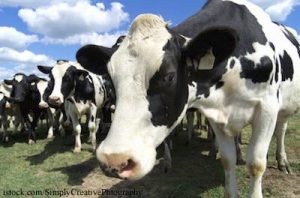The USDA has issued its final report on the investigation into bovine spongiform encephalopathy (BSE), popularly known as Mad Cow disease, on a California dairy cow in April 2012. The USDA’s Animal and Plant Health Inspection Service (APHIS) worked with the FDA, the California Department of Food and Agriculture, and local officials on the investigation.
 The investigation included on-the-ground investigations, records review from the rendering facility, the farm and associated premises, and traceback for progeny of the affected cow. The agencies have concluded that “at no time was the U.S. food supply or human health at risk, and that the United States’ longstanding system of interlocking safeguards against BSE continues to be effective.” The animal was never slaughtered for human consumption so did not present a risk to the food supply.
The investigation included on-the-ground investigations, records review from the rendering facility, the farm and associated premises, and traceback for progeny of the affected cow. The agencies have concluded that “at no time was the U.S. food supply or human health at risk, and that the United States’ longstanding system of interlocking safeguards against BSE continues to be effective.” The animal was never slaughtered for human consumption so did not present a risk to the food supply.
The animal was a 10 year, 7 month-old Holstein cow from a dairy in central California. After the cow lost the ability to walk, it was euthanized and sampled as part of the USDA’s BSE surveillance program. Results confirmed the positive test for atypical BSE. Samples were sent to the World Health ORganization for Animal Health labs in CAnada and England.
The cow had one live offspring, which was euthanized and tested. It was negative for BSE. No “birth cohorts” of the animal were found alive.
A feed investigation found that twelve feed suppliers provided feed to the farm. One was no longer in business. The other eleven were in compliance with FDA and CDFA regulations. You can see a full report on the feed investigation at the FDA web site. None of the facilities had used prohibited material in their feed, although one had distributed prohibited material but didn’t use it to manufacture feed.
Six facilities used only vegetable protein sources. Five used blood meal (one used only porcine origin blood meal). Two facilities used feather meal protein, two used fish meal, and one used porcine origin MBM.





The fault lies with the consumer. We don’t want the meat to be diseased so it isn’t.
The California dairy cow found to have mad cow disease apparently came from herd with a high yield, and milk production. WHY? US different breeds produce within a range of around 6,800 to 17,000 kg (15,000 to 37,500 lbs) of milk per lactation. The average for a single dairy cow in the US in 2007 was 9164.4 kg, and California is truly the nation’s dairy state. It leads the U.S. in the production of total milk. Tulare County is the number one county in the state and nation in annual milk production, totaling more than $1.6 billion, according to the 2010 Tulare County Agricultural Crop and Livestock Report. Tulare County is home to the largest dairy farms on the planet with a population of about 500,000 dairy cows….
Dairy cows with high milk production need in the feed ration a high concentration of protein. From experiences in the Czech Republic is known that almost all the 30 cases of mad cow disease (BSE) had been detected in high commercial dairy farms. For this, two cases of BSE have been repeatedly found in two herds of dairy cows. Even the last case was detected in the farm where high yielding dairy cows were fed organically (grass pasture) but had the possibility of unlimited (ad libitum) intake of protein concentrate. Why the BSE disease occurred only in a highly commercial farms and not in the thousands of other breeds with a lower milk yield, when meat and bone meal was in the Czech Republic never fed in dairy cows (in cattle)?
The neurodegenerative diseases, occurred to a greater extent, only in ruminants (BSE), because only in them, magnesium is not absorbed in the intestine, but in the rumen. The excess of protein-nitrogen in the rumen decreases absorption of magnesium. Most suffer with magnesium deficiency, high yielding dairy cows, in which high milk production leads to the dysbalancy between calcium and magnesium. Prolonged magnesium deficiency leads to an excess of calcium in animal tissues, and NMDA receptor hyperfunction.
According to my opinion (BSE ammonia- magnesium theory), the origins of the neurodegenerative diseases may lie in chronic magnesium deficiency coupled with a high protein intake. So defective prions are markers of the diseases rather than the cause and BSE can be a naturally occurring disease, and not an infectious disease.
Why should prions be some markers? This option shows the results of recent research of Alzheimer’s disease (July 2012). About this disease is known that
the aggregation and deposition of amyloid-β (Aβ) peptides are believed to be central events in the pathogenesis of Alzheimer’s disease (AD). Many similar scientific methods led the 1997 Nobel laureate Stanley Prusiner, to prove that a protein had the machinery to self-propagate into a misfolded infectious state. At the time, 20 years ago, he put forth the idea that prions could be involved with other neurodegenerative diseases. However, recently (July 2012) his team reported compelling evidence that Aβ aggregates are prions and that the formation of Aβ prions does not require additional proteins or co-factors.
It’s the weather here. It never gets too cold or hot in the valley. No winter stress. That bumps the yearly milk average way up.